Rare Small Mammals of North America
Listed here are ten of the rabbits and rodents that in the last couple of decades have been documented as some of the rarest and most critically endangered mammals in Canada and United States.
Many of these are subspecies that live well-isolated from any closely-related animals.
In their isolation, they've come to specialize at surviving in a very particular kind of habitat. Florida and California are exceptionally rich in these kind of animals, and together house the bulk of the rarest small mammals in the USA.
We do not have a comprehensive inventory for every species and subspecies of mammal in North America. Not many populations of small animals in Canada and United States are closely monitored. This list reflects those rabbits, mice, squirrels and their relatives that have garnered enough attention and funding to develop survey techniques and estimate their numbers. The results show that many of these rare mammals have been heading towards extinction.

Florida Salt Marsh Vole
Microtus pennsylvanicus dukecampbelli
Since its discovery in 1979, this dark-colored subspecies of meadow vole was so rare that in the next 25 years it was seen only 15 times. All the sightings happened at Waccasassa Bay on Florida's Big Bend region of the Gulf Coast, despite many attempts to find the tiny creature elsewhere.
A breakthrough came in April 2004 when biologists searching in promising habitat captured three individuals at Lower Suwannee National Wildlife Refuge. The find confirmed for the first time that more than one Florida salt marsh vole population did exist.
The vole's compact range of salt marshes dominated by seashore salt grass makes this habitat specialist vulnerable to being decimated entirely by a single unfortunate event, such as a storm surge generated by a hurricane.
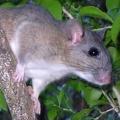
Key Largo Woodrat
Neotoma floridana smalli
This woodrat subspecies is native only to one island, Key Largo in Florida. Much of its tropical hardwood hammock habitat has been cleared and developed.
A 1979 survey estimated 645 of the lodge-building mammals inhabited an area of 222 acres (90 hectares). Within a few years, the population began a rapid decline that's still continuing.
Woodrats are now restricted to the northern end of the island where hundreds of feral cats and fire ants may be shortening the native animal's lifespan. A 2006 estimate concluded that somewhere between 40 to 106 Key Largo woodrats remained wild and another 28 lived in captivity.
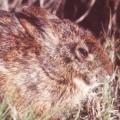
Lower Keys Marsh Rabbit
Sylvilagus palustris hefneri
Development of freshwater marshes and coastal berms in the Florida keys caused much of this rabbit's habitat to become fragmented and destroyed. Domestic cats killing both bunnies and adult rabbits are another major threat to the marsh rabbit's survival.
Since 1995, the endangered rabbits have disappeared entirely from three keys. There were around 500 rabbits in 2006 that occupied 118 patches, totalling 600 acres (243 ha). Every year between 2001 and 2005, rabbits got wiped out at several more patches. Recent efforts to move rabbits into new habitat and release captive-bred young may eventually turn the decline around.
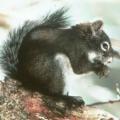
Mt Graham Red Squirrel
Tamiasciurus hudsonicus grahamensis
This remote subspecies of red squirrel lives only at high elevations in the Pinaleno Mountains of southeastern Arizona. A century ago they were abundant, but by the 1960s they'd become so rare they were considered extinct. Logging and roads had removed much of the animal's old-growth coniferous forest habitat.
Years later, the squirrels were rediscovered and surveys since the mid-1980s have counted anywhere from 250 to 550 individuals. The latest census in late 2007 totalled 299 squirrels.
Insects and forest fires have recently killed trees in the Pinaleno Range. The resulting scarcity of cones that supply the squirrel's staple food may be restricting the mammal's numbers.
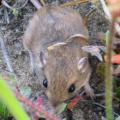
Pacific Pocket Mouse
Perognathus longimembris pacificus
Nearly all of the coastal sage scrub in southern California that the tiny Pacific pocket mouse specializes at living in has gone, converted to agriculture or urban sprawl. Once known from 29 sites, the small mammal's numbers began plummeting in the 1940s.
Now only four Pacific pocket mice populations are known to exist, three of these on a military base. Two of the populations have less than 50 individuals.

Point Arena Mountain Beaver
Aplodontia rufa nigra
This unusual black-colored subspecies of the primitive mountain beaver only occurs on 24 square miles (62 km²) in coastal Mendocino County, north of San Francisco, California. A substantial amount of their habitat is lost to agricultural and urban development, or degraded by livestock grazing and brush clearing.
There were 26 populations identified in 1988, totalling 200 to 500 animals. Since then, more colonies have been discovered.
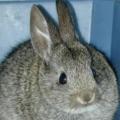
Riparian Brush Rabbit
Sylvilagus bachmani riparius
By the 1980s, this rare cottontail was found only on 258 acres (105 ha) along the Stanislaus River in Caswell Memorial State Park, situated inland from San Francisco. It probably once lived in shrub thickets flanking several rivers including the Merced, Tuolumne and lower San Joaquin. But now less than 1% of the original brush rabbit habitat remains in San Joaquin Valley, mainly due to dams and agriculture.
The park's wild rabbit population was reduced to less than two dozen individuals during flooding in 1983 and again in 1986. Their number grew to 241 rabbits in 1993 only to be decimated again by floods in 1997. Although a few rabbits survived, the population never rebounded from the 1997 disaster. Predation by pet cats left abandoned in the park has likely kept these rabbits at the brink of extinction.
Fortunately, a second group of brush rabbits was discovered in 1998, located 24 miles away on private land. With somewhere between 25 and 100 individuals, this new find provided the numbers needed for establishing a captive breeding program. Beginning in 2002, young rabbits born in captivity were released at new locations.

San Joaquin Valley Woodrat
Neotoma fuscipes riparia
This sizeable subspecies of woodrat was believed confined in the 1990s to 225 acres (91 acres) of riparian forest in California's Caswell Memorial State Park near Modesto. Estimates in 1992 put the total population at 437 to 637 animals.
Few survived after six weeks of flooding in 1997, and only eight woodrats were spotted in the following months. Recently, two more populations were located in the northern San Joaquin Valley. At all the sites, large numbers of introduced black rats compete with the native subspecies, hampering its survival.
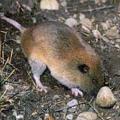
Shelton Pocket Gopher
Thomomys mazama couchi
An isolated subspecies of Mazama pocket gopher inhabits a tiny remnant of prairie near Shelton, lying west of Puget Sound in Washington state. Its little remaining habitat is severely degraded and overrun by introduced vegetation.
The rare gopher has disappeared from several prairies where it was collected in the 1940s and 1950s. The one currently confirmed location harboured an estimated 200 to 400 animals in 1996. They may also occur at two other nearby sites, but no reliable surveys of Shelton pocket gophers exist.

Vancouver Island Marmot
Marmota vancouverensis
About 350 marmots were living in the mountains of Vancouver Island during the 1980s. Soon afterwards, at least a dozen marmot colonies disappeared, probably due to changes in subalpine vegetation. By the mid 1990s, less than 100 of the endangered Vancouver Island marmots were left.
Marmots gave birth in captivity for the first time in 2000, bringing their numbers to 40 at breeding centres, while another 36 remained in the wild. Since then, captive-born marmots have been released into their native alpine meadows.
Although natural predators have plagued a program of rebuilding the wild marmot population, their numbers are increasing. As of late 2007, there were 252 Vancouver Island marmots, of which 90 lived wild.